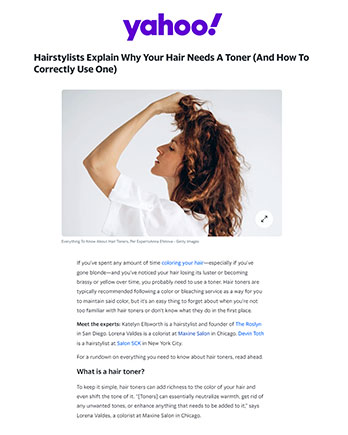Yahoo September 10, 2023
 Yahoo
Yahoo
Life
Hairstylists Explain Why Your Hair Needs A Toner (And How To Correctly Use One)
If you've spent any amount of time coloring your hair—especially if you've gone blonde—and you've noticed your hair losing its luster or becoming brassy or yellow over time, you probably need to use a toner. Hair toners are typically recommended following a color or bleaching service as a way for you to maintain said color, but it's an easy thing to forget about when you're not too familiar with hair toners or don't know what they do in the first place.
Meet the experts:
Katelyn Ellsworth is a hairstylist and founder of The Roslyn in San Diego.
Lorena Valdes is a colorist at Maxine Salon in Chicago.
Devin Toth is a hairstylist at Salon SCK in New York City.
For a rundown on everything you need to know about hair toners, read ahead.
What is a hair toner?
To keep it simple, hair toners can add richness to the color of your hair and even shift the tone of it. “[Toners] can essentially neutralize warmth, get rid of any unwanted tones, or enhance anything that needs to be added to it,” says Lorena Valdes, a colorist at Maxine Salon in Chicago.
Most at-home toners usually take the form of toning shampoos and conditioners; purple shampoos are usually recommended for toning brassiness in blonde and gray hair while blue shampoos are designed to color-correct hair that's been dyed brown.
If you're getting your hair toned at a salon, your hairstylist might use a hair gloss, a non-permanent coloring method that “glosses” your hair, per hairstylist Devin Toth. “They have a translucent sheen to them and can be used to adjust the warmth or coolness of blonde hair," Toth previously told WH. "They can blend grays away and they can add tremendous depth to dull brown hair.” These types of toners typically last around four to six weeks, says hairstylist Katelyn Ellsworth, while semi-permanent toners can last six to eight weeks.
Why would someone need a hair toner?
Anyone who's had their hair bleached or colored will likely need a toner to maintain it and avoid brassiness or unwanted tones that may be a result of excessive washing, swimming in water with chlorine, hot water exposure, and even sun exposure. There’s also the possibility that a person’s hair simply can't hold onto color well. In this case, a toner will help add layers and dimension.
According to Valdes, a person might also want to use a toner to change the texture of their hair. “There's people that have super silky fine hair that goes limp naturally, so they could love their natural hair and want the texture that comes from the toning,” says Valdes.
What are the benefits of using a hair toner?
If you’re a brunette or have darker hair, a toner can richen your color, and if you’re a blonde, a toner can brighten you up, says Ellsworth. She adds that a toner can also soften, add shine, and strengthen your hair, and because toners don’t last long in the grand scheme of things, they're perfect for people who prefer low-commitment alterations.
Can you use toners on all hair colors?
In short, yes. Toners can be used on all colors and textures, from black to gray and white hair. Ellsworth notes that even damaged hair can benefit from toners since they can condition and strengthen porosity. “It's just a matter of communicating with your stylists about what you feel like your hair may need,” adds Valdes.
How to use a hair toner at home
When toning your hair at home, Valdes recommends doing a patch test with a small piece of hair to see how it looks when it dries before moving to the rest. “When it comes to at-home products, there's usually either an overload or underload of pigment since it's marketed to a variety of people—it can be very unpredictable for clients,” says Valdes. Additionally, the toner may work differently for people who have highlights.
Ellsworth suggests using a toner that's sulfate-free and comes in a shampoo or conditioner since it won’t have ammonia. You should start by applying the toner starting at the root through the middle sections of your hair. Then, comb the product through so that any extra or remaining toner makes its way to your tips. “Your ends will pick up and let go of the color quicker because of the porosity and longevity—they've seen a lot more life,” she explains.
Once applied, leave the toner in your hair for five to 15 minutes, depending on the directions on the label, before rinsing and drying. If you’re using a gloss, you can shampoo your hair first, and then apply it using a bottle or bowl and a brush.
This content is imported from poll. You may be able to find the same content in another format, or you may be able to find more information, at their web site.
Advertisement - Continue Reading Below
If you're not sure what color toner to use, consider the color of your hair and what you're trying to cancel out: use purple-based toners to cancel out yellow tones, use blue-based toners to cancel out orange, and use green-based toners to cancel out red.
Once the color has washed out following the four to six week period, you can go back to the salon or re-tone your hair at home again.
"You're continuously adding pigments, so it will add up on top of each other and progress," says Ellsworth. "If you're doing a major process, I always recommend doing it in the salon with a professional guiding you on how to maintain the color. Over time, they'll be able to prescribe or help guide you in the right direction of what would be the best to do at home."
